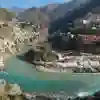Monterey Coordinated Canyon Experiment
The University of Hull is part of an international research team monitoring high-energy currents along a 50 kilometre (31 mile) stretch of Monterey Canyon in California
Project summary
The Challenge
Seafloor avalanches transport vast quantities of sediment to the deep ocean and pose major risks to subsea infrastructure, but our understanding is based on limited field data.
The Approach
The most intensive monitoring campaign to date was undertaken in Monterey Canyon over 18 months using the combined equipment and expertise of several international partners.
The Outcome
A better understanding of the frequency and duration of canyon sediment flows as well as new and fundamental insights into flow initiation and seafloor interactions.
Institutes and centres
Lead academics
The Challenge
Scientists have known about turbidity currents since at least 1929, when a large earthquake triggered a violent current that travelled several hundred kilometres and damaged 12 trans-Atlantic communications cables.
Turbidity currents are a major threat today, as people place more and more cables, pipelines, and other structures on the seafloor. Turbidity currents are also important to petroleum geologists because they leave behind layers of sediment that comprise some of the world’s largest oil reserves.
Despite almost a century of research, turbidity currents are one of the least understood phenomena on our planet. The highly energetic nature of the flows, combined with their episodic nature, has until recently thwarted attempts to monitor turbidity currents and geologists have struggled to come up with a conceptual model that describes in detail how turbidity currents form and evolve.
The Approach
Special instruments were developed for the Monterey project that could withstand the forces generated as the flows raced past the instrument frames and moorings, but that could also capture essential information about the behaviour of these flows. Unprecedented detail was captured using an array of highly-specialised instruments including ‘smart boulders’ and acoustic flow meters deployed over a distance of 50 km to a depth of 1,850 metres. During the experiment, researchers placed over 50 different instruments at seven different locations distributed along the canyon floor and made detailed measurements during 15 different turbidity flows.
The researchers also placed beach-ball-sized sensors called benthic event detectors (BEDs) in the seafloor. The BEDs were designed to be transported by turbidity flows while carrying instruments that recorded their depth, horizontal and vertical movement, and rotation. Other motion sensors were mounted on large, steel frames weighing up to 800 kilograms (1,760 pounds). These were designed to remain stationary while the flows passed around them.
This is the most comprehensive monitoring of a submarine canyon to date and it has helped us to fundamentally change our understanding of how these enigmatic flows shape the seafloor and transport huge volumes of sediment to the deep ocean.Dr Steve Simmons
Energy and Environment Lecturer, University of Hull
The Impact
The combined expertise of earth scientists, engineers and technical capabilities across a range of international partners have come together to produce a step-change in our understanding of these submarine systems, which are the biggest channels on Earth. The partners were able to infer that they consist of fast and dense near-bed layers, caused by remobilisation of the seafloor, overlain by dilute clouds of suspended sediment. The seabed itself becomes mobile in the upper reaches of the canyon, probably due to a process known as liquefaction, with the heavy instruments rafted within the fast-moving dense layer of sediment. This discovery could help ocean engineers avoid damage to pipelines, communications cables, and other seafloor structures.
The discovery relating to how these flows destabilise the ocean floor, which has been published in the prestigious Nature Communications, will lead to greater understanding of:
- Earth’s geological history by improved interpretation of the flows and the ‘barcode-like’ deposits left behind
- The risk these currents pose to global data communications between countries resulting from cable breaks, as well as gas and oil pipeline infrastructure
- The impact these currents have on the carbon cycle by transporting and burying globally significant amounts of organic carbon into the deep ocean, effectively locking it away.








